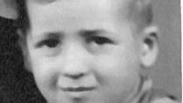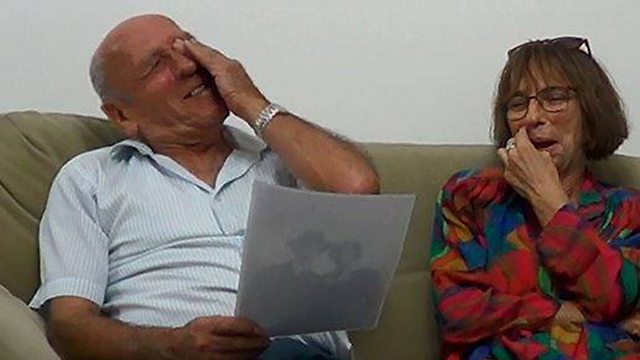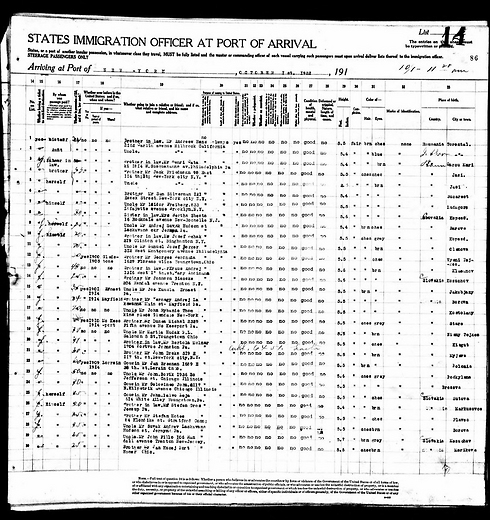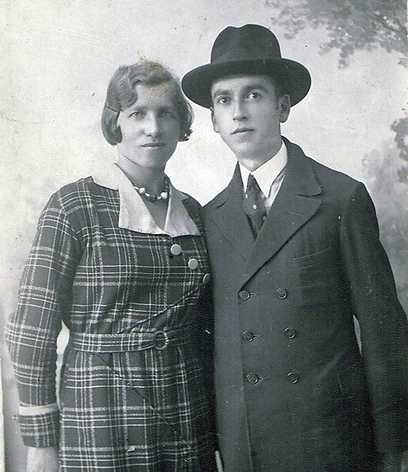
Auschwitz prisoner No. A7733 finally finds his family
Menachem Bodner, a twin survivor of the Mengele experiments, lost his entire family when he was just a little boy. He is still searching for his twin brother, but recently found his first cousins in California thanks to a persistent genealogist.
About a year and a half ago, Ynet published the story of Menachem Bodner, a twin survivor of the Mengele experiments, who after 70 years, thanks to a persistent genealogy researcher, discovered his real name, his place of birth and the fact that he has distant relatives living in Israel.
Recently, thanks to a DNA test and a research of his roots in the United States, Bodner discovered cousins he never knew he had, and held a video chat with them from California last week.
In addition, for the first time in his adult life, he received a picture of his parents, who were erased from his scarred memory of Auschwitz and who he had not seen since the family was sent to the camps by the Gestapo.
However, the journey in search of his twin brother Jeno, prisoner No. A7734, still continues.
The Facebook page "A7734: Looking for twin brother Jeno (Jolli), Auschwitz/Mengele survivor," which was launched in April 2013, revealed the personal story of Menachem Bodner, a resident of central Israel, who survived the Holocaust on his own even though he was under the age of 4 when he was taken to a concentration camp with his brother.
At the end of the war, he was adopted in Auschwitz by two Holocaust survivors who gave him their last name, but for the duration f his life he harbored the feeling that his twin brother had also survived. For 68 years, he did not know what had happened to the rest of his family.
Ayana KimRon, a diligent genealogist, found a message Bodner had written in a family roots forum on the Internet and rose to the challenge. Sensitively and skillfully, she opened up his heart, and through the number on his hand and by digging into the Nazis' different archives, she managed to come up with his real name and place of birth.
Elias Gottesman was Menachem's real name. Jeno Gottesman was the name of his twin brother who was lost in Auschwitz. The two were born in the Mukacheve area in the Carpathian Mountains in Hungary.
Thanks to these details, KimRon located relatives in Israel who helped her find out what happened to the mother, Roza, who survived the march of death from the Flossenbürg labor camp and managed to return after the war to her hometown, where she was murdered in 1946 by anti-Semitic rioters.
But too many ends of the story remained unsolved. Slowly, through a cross-continent effort, she managed to put these ends together too.
American company offers to help
Following the publication, KimRon began receiving a lot of information via email, but nothing led to a breakthrough. And so, with no real lead, she decided to focus on the mother, Roza.
"I received a clue that the mother's sister or aunt – it wasn't entirely clear – had probably immigrated to the United States in the early 20th century, years before the war," KimRon told Ynet. "All I had was a first name – Mary. I didn't know her last name and where she was located on the family tree.
"I began using my method to search all the American immigration archives and didn't really find anything. I decided to make a wise gamble: To assume that since Mary is an Anglo name which is not so common in Eastern Europe, she likely entered the US with a different first name. I put her aside and decided to let fate play the game."
And it did. Last May, KimRon received a notification letting her know she had a new email in her inbox. When she opened it, she found an interesting proposal from the 23andMe company, which is considered one of the three leading DNA banks in the world.
"They read the publications and offered their help," she says. "They asked Menachem to donate a DNA sample, and if the system would find any match – based on the slim chance that his twin brother had once given a DNA sample in the US – it would be their modest contribution to the project.
"Menachem provided a sample and we sent it. From that moment, each time the system finds a match, I receive an email notification. I received quite a few emails about distant levels of relation, but none of them was interesting enough and Menachem asked not to be updated on distant relations so as not to mentally burden him."
The breakthrough arrived on October 17. The headline of the message was: "We found you a new relative."
"I miss a heartbeat every time such an email arrives," KimRon explains. "I went in to check the new match. It was an anonymous profile, but the system marked it as a first cousin, and the company informed me that it was a 'definite match.' As a researcher, I doubted it.
"I sent an invitation to the anonymous profile to clarify the relation, along with a small prologue from Menachem introducing him as a Holocaust survivor who is looking for his relatives and who has had no information of his identity for many years. But I got no answer. I went to the inbox every three hours, and there was nothing."
There were very few details on the anonymous profile page, but there was enough to make KimRon set her research in motion.
"I reviewed the profile again and again, saw that three countries were entered – the US, Slovakia and Ukraine – and two last names – Berger and Burstein – and that the DNA group belongs to the mother.
"It was a dramatic match. One of the assumptions was that Berger was the mother's maiden name, and the fact that they put Slovakia and Ukraine together with the US was enough for me to conclude that I may have found a connection to Mary."
At this stage, the search focused on two American databases: Ancestry and Ellis Island.
"I searched for a woman named Berger who had married a Burstein and I found marriage documents in the databases," she recounts. "I removed all the Bergers who were not born in Hungary and was left with two Berger-Burstein couples. And then it jumped out of the page: Mary Burstein, née Berger. My heart missed a beat and I entered the document.
"It turned out that Mary was born in a remote village in the Carpathian Mountains, which used to be in Hungary and is now in Ukraine. That's the village were Roza, Menachem's mother, was born. And Mary's father had the same name as Menachem's grandfather. There was no room for doubt – Mary is Roza's sister. I reached the Mary I was looking for."
For expert genealogists, databases are a treasure. All they have to know is how to dig through them in order to find the required information. After locating Mary, KimRon found her place of burial on the Web and even a picture of the grave itself, "with her Yiddish name on it and Mary Burstein in English." Bingo.
Suddenly the memory has a face
Mary has three daughters, and the three of them still live in the US. The database documents revealed their identity, their place of birth, where they moved to and when Mary was widowed.
At this stage, KimRon was careful not to tell Menachem about the breakthrough as she was afraid to disappoint him if it turned out she was wrong. "I stopped to drink water and relax, took a deep breath and considered whether I should tell Menachem or not. But I decided to wait."
The fear was alleviated only after a response arrived from the anonymous profile, from one of Mary's daughters in California. "Our entire family died in the Holocaust," the daughter wrote in the email. "Not your entire family," KimRon responded. "You have a relative in Israel."
KimRon updated Menachem about the dramatic chain of events. He was excited. "It was the most exciting discovery I had ever experienced," he said. "The DNA left no room for doubt."
The cousin said she had never imagined that she had relatives who survived the Holocaust. She explained that she had given the DNA sample in the past for medical needs. She said she had heard a lot about Aunt Roza, Menachem's mother, who was her mother's favorite sister. Her daughter, Mary's granddaughter, is even named after her.
Mary, it turned out, had immigrated to the US in 1920, and the sisters lost contact with each other immediately at the start of World War II. She told her daughters she had known something bad had happened when the letters she had sent Roza didn't reach their destinations and were sent back to the US.
Menachem didn't remember what his parents looked like. All he had was a vague memory of a three-year-old child who was left alone in the world. All the remained was a mixture of images and colors of him and his family being removed from their house by the Gestapo.
"Do you have any pictures of Roza?" KimRon asked the cousin, who said she did. She quickly emailed a photo clearly showing Roza and Ignatz Gottesman, Menachem's parents.
The parents, who up to two weeks ago were faceless in Menachem's scarred memory, were suddenly looking at the camera. In this long journey in search of his relatives, the most exciting moment was when Menachem first received his parents' picture. Apart from his mother's blonde hair, he couldn't remember anything. It was all erased by Auschwitz.
What happened to Jeno?
Last Sunday, at KimRon's house in the Israeli city of Hod Hasharon, Menachem Bodner chatted with his relatives in the US via video chat for the very first time. For about two and a half exciting hours, Bodner and KimRon got to speak to Mary's three daughters, their children and their grandchildren.
The sisters told Menachem everything they knew about his mother: That she was a professional seamstress and embroiderer, and that she had survived the war but was murdered by rioters later on.
"They were sensitive and were afraid to cause him pain," KimRon said. "They didn't ask anything about the Holocaust. They wanted to know what he had done in Israel and asked him to tell them about his family."
Before concluding the conversation, they agreed to meet in the US and get to know the entire extended family. By the time the video chat had come to an end, Bodner was glowing, happy. It was another moment in the emotional rollercoaster he had experienced in the past year and a half, thanks to KimRon.
Only one thing remains open: What happened to Jeno, the twin brother? The relatives in California offered to help and promised to do everything in their power in the US to help solve the mystery.
KimRon and Bodner are particularly optimistic. They feel they have taken another step forward towards Menachem's lost brother.
In the meantime, Menachem holds onto the only memory he has of him: Lying on the bed with his eyes closed, in deep sleep. Sleeping in the bed they shared, foot by foot, until the Gestapo men knocked on the door of the house. That is the only picture of his twin brother engraved in his memory.













